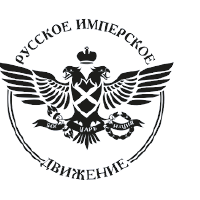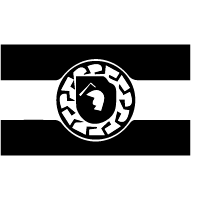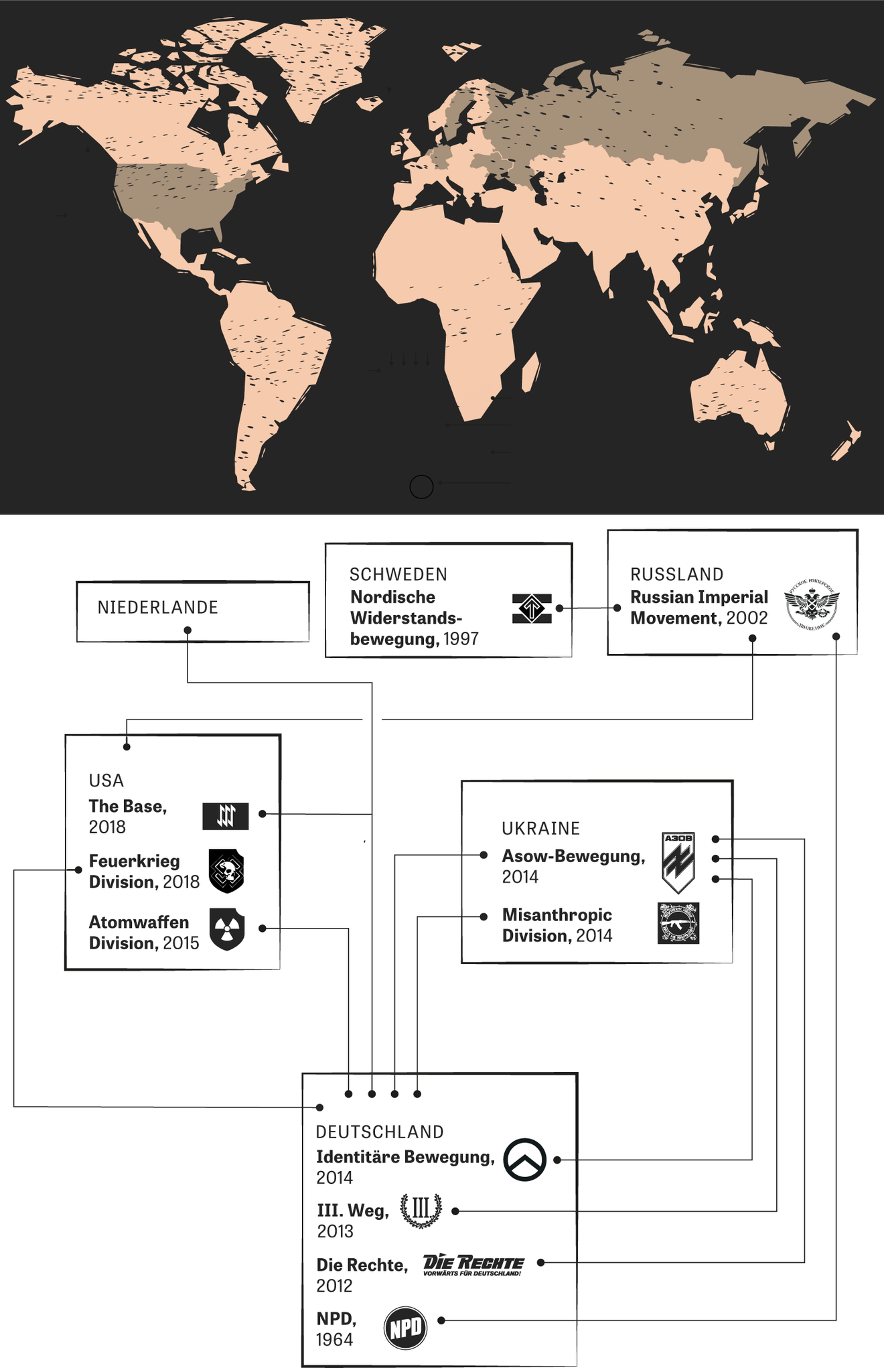Kai Biermann, Christian Fuchs, Astrid Geisler, Yassin Musharbash und Holger Stark

German neo-Nazis who head abroad to fight. American masterminds who dream of a fascist revolution. A former Russian soldier who provides weapons training to right-wing extremists from across Europe. The new right wing is networked internationally – and is growing more dangerous.
The hate preacher lives in a run-down rear building in the heart of Denver, on the second floor through the courtyard to the right. The TV is on. We knock, hoping to ask him a few questions about the new, globalized Nazi movement. After all, he’s one of the masterminds behind it.
The door opens. “Come on in,” says James Mason.
His full beard is icy gray and he is wearing a white-and-blue pinstriped shirt and pleated trousers. On the bookshelf are numerous works with titles like “Blood & Honor” and, in German, “Der Gauleiter” and “Deutschland Erwache! (Germany Wake Up!)” A ticking cuckoo clock hangs on the wall, going off every half hour.
This aging gentleman of 68 years is a legend among neo-Nazis. Mason was just 14 when he joined the youth wing of the American Nazi Party, and he later went on to became one of the most important right-wing extremists in the United States. He romanticized Hitler just as he did serial killer Charles Manson, propagating violence and terror and spending some time in prison. In 1992, he published a book called “Siege.”
It includes sentences like: “Let us give some thought to what the next logical step might be toward opening the way to full, revolutionary conflagration in the United States.” Anything which contributes to “friction, chaos and anarchy” is helpful, he writes, from “random shootings” to “select and consecutive assassinations … in different parts of the country.”
The classic fascist groups and parties of the 20th century were hierarchical, with a leader at the top, chains of command and military structures. In “Siege,” though, James Mason presents a different concept: Ideally, people would organize in small cells. Or they would launch attacks completely on their own, because in some cases, two is one too many. “We must view and realize that all of White America is our army,” Mason writes.
There is a photo from 2019 showing James Mason together with 12 men. Mason is sitting on a chair in the center wearing a brown shirt and a swastika armband. The men are kneeling or standing around him, all wearing camouflage and skull masks. They are members of the Atomwaffen Division, gathered for a meeting in Las Vegas, with Mason there as a kind of guest of honor. Atomwaffen Division, in German, is their real name. The English translation would be “Atomic Weapons Division.” Founded in 2015, the neo-Nazi group is one of the most hardcore in the world, with AWD members in the U.S. suspected of having committed five murders. And it is heavily influenced by the idea of “leaderless resistance” propagated by James Mason.
“A wonderful, wonderful association,” Mason says in his living room. “Bravehearts.” The idea behind AWD, as the group is known for short, is to “take the fight to the enemy” – and not just in the U.S. AWD now has offshoots in a number of different countries, including Germany. “There was a lot of action in the Ukraine and … clear across Europe, and certainly here,” Mason says. “That’s pretty impressive, I have to admit.”
Almost a year ago, in spring 2020, Mason announced that the Atomwaffen Division was disbanding, but that was likely just a tactical move to alleviate the pressure of FBI investigations. “One name may be disbanded, it may be outlawed,” Mason says. “You pick up another, like changing your underwear, and it means nothing.”
You can tell he’s proud of his role as the movement’s intellectual leader. At the same time, though, he seems to choose his words with care to avoid saying anything that could be interpreted as an incitement to violence. Mason claims to no longer believe in the idea of right-wing terror. But, he adds, “so many just aren’t ready to give it up.”
Unfortunately, it seems that Mason might be right.
In the U.S., there is a successor organization to the AWD called the National Socialist Order. It appears to be made up in part of the same men, just wearing different underwear. Many neo-Nazis who are not involved in the AWD also look to Mason for guidance. In one memo, the FBI mentions a “Siege network,” which they describe as a global network of online channels and real-world groups that cooperate with each other in analog reality.
Globally oriented right-wing extremists: It sounds like a contradiction. Wasn’t it the left-wing extremist terror groups – like the Red Army Faction in Germany – that dreamed of a “worldwide front”? The RAF allied itself with the IRA in Northern Ireland, the Palestinian PLO and the FNL in North Vietnam. Their members received military training in camps in the Middle East. Jihadism is also based on the idea of a global community that knows no national boundaries. But neo-Nazis? Don’t they chant things like “Germany for the Germans!” or “Les Français d’abord!” – “The French first!”?
That used to be the case. But not anymore.
In recent years, “a new, leaderless transnational, apocalyptic and violent XRW (extreme right wing) movement has emerged and continued to evolve between 2015 and 2020,” write experts in a recent study conducted on behalf of the German Foreign Ministry.
A report from the European police agency Europol notes that the right-wing extremist scene in numerous European countries has internationalized.
And the Counter-Terrorism Committee of the United Nations Security Council has determined that between 2015 and 2020, there has been a steep rise in the number of right-wing terrorist attacks around the world – a spike of fully 320 percent.
Journalists from DIE ZEIT conducted reporting in six different countries for this story, examining files, conducting interviews and attending court hearings. Some of the characters in this account are key figures of international importance, while others are solitary misfits sitting in front of their computers. One operates a paramilitary training camp, another – a young German man – was almost ready to go to war. All of them, though, have one thing in common: They are part of something new, something that could perhaps be called the Brown Internationale.
The Allure of War
Felix Oberhuber walks fast and talks fast. It is the first time he is telling his story to someone who isn’t a family member or part of the neo-Nazi scene. His boots crunch on the icy lane, the Alps spread out on the horizon in front of him. Oberhuber is wearing a wool cap and a camouflage jacket, a stout 22-year-old who could be James Mason’s grandson. Until two years ago, he focused his efforts on connecting right-wing extremists from Germany and Ukraine, and the authorities still consider him a potential threat today. But he says he no longer wants to have anything to do with the scene. Because he lives in fear of his former comrades, we are not using his real name for this story.
When asked for evidence to prove his story, Oberhuber rolls up the sleeve of his military jacket to show a tattoo on his arm. “Misanthropic Division” it reads.
The MD is a paramilitary right-wing extremist group from Ukraine that follows the motto “Kill for Wotan.” Oberhuber was the leader of the group’s Germany chapter until 2019. He has more tattoos on his legs, including runes and a swastika. DIE ZEIT also spoke with his father, examined documents and asked around in his surroundings to verify his story.
Important right-wing extremist organizations, the year they were founded and the international ties they maintain
Source: own research© ZEIT-GRAFIK: Anne Gerdes
Nordic Resistance Movement The Nordic Resistance Movement (NRM) is a grouping of violence-prone neo-Nazi groups active in Scandinavia. It is estimated to have around 300 members. The primary focus of NRM activities is Sweden, where the organization is also present as a political party. For years, NRM has maintained ties to the Russian Imperial Movement.
The Nordic Resistance Movement (NRM) is a grouping of violence-prone neo-Nazi groups active in Scandinavia. It is estimated to have around 300 members. The primary focus of NRM activities is Sweden, where the organization is also present as a political party. For years, NRM has maintained ties to the Russian Imperial Movement.
Russian Imperial Movement The Russian Imperial Movement (RIM) is an ultra-nationalist group that dreams of the reincarnation of the Russian Empire and the return of the czars. RIM also has an armed wing, called the Imperial Legion, which was active in the Ukraine conflict on behalf of the pro-Russian separatists. In 2020, the group was included on the U.S. State Department’s list of terrorist organizations. Leader Denis Gariev operates a paramilitary training camp in St. Petersburg, where German right-wing extremists have also received instruction. RIM has close ties with right-wing groups in other countries, including the right-wing extremist National Democratic Party of Germany (NPD).
The Russian Imperial Movement (RIM) is an ultra-nationalist group that dreams of the reincarnation of the Russian Empire and the return of the czars. RIM also has an armed wing, called the Imperial Legion, which was active in the Ukraine conflict on behalf of the pro-Russian separatists. In 2020, the group was included on the U.S. State Department’s list of terrorist organizations. Leader Denis Gariev operates a paramilitary training camp in St. Petersburg, where German right-wing extremists have also received instruction. RIM has close ties with right-wing groups in other countries, including the right-wing extremist National Democratic Party of Germany (NPD).
The Base Founded in 2018 by Rinaldo Nazzaro, the FBI believes The Base aims to establish a “white, ethno-state” and that it encourages violence and attacks to accelerate the outbreak of a civil war, which the group believes is approaching. Several Base members in the U.S. have been accused of planning terrorist activities. Experts believe that The Base has cells in Canada, Australia, South Africa and European countries.
Founded in 2018 by Rinaldo Nazzaro, the FBI believes The Base aims to establish a “white, ethno-state” and that it encourages violence and attacks to accelerate the outbreak of a civil war, which the group believes is approaching. Several Base members in the U.S. have been accused of planning terrorist activities. Experts believe that The Base has cells in Canada, Australia, South Africa and European countries.
Atomwaffen Division A neo-Nazi organization that was established in the U.S. in 2015, Atomwaffen Division ideology leans heavily on the book of essays called “Siege,” written by James Mason. AWD members have been accused in the U.S. of committing five murders. The group has followers in several European countries, including Germany, where public prosecutors have launched an investigation, DIE ZEIT has learned.
A neo-Nazi organization that was established in the U.S. in 2015, Atomwaffen Division ideology leans heavily on the book of essays called “Siege,” written by James Mason. AWD members have been accused in the U.S. of committing five murders. The group has followers in several European countries, including Germany, where public prosecutors have launched an investigation, DIE ZEIT has learned.
Feuerkrieg Division  A neo-Nazi group that is believed to have formed in late 2018, the Feuerkrieg Division (FKD) is an emulation of the Atomwaffen Division. It has members in numerous countries in Europe, including Germany. On the internet, FKD has called on members to commit violent acts on several occasions, especially against Jews and migrants. The year 2020 marked the first time a member of an FKD chat faced prosecution in Germany. The defendant was convicted of planning a seditious criminal act.
A neo-Nazi group that is believed to have formed in late 2018, the Feuerkrieg Division (FKD) is an emulation of the Atomwaffen Division. It has members in numerous countries in Europe, including Germany. On the internet, FKD has called on members to commit violent acts on several occasions, especially against Jews and migrants. The year 2020 marked the first time a member of an FKD chat faced prosecution in Germany. The defendant was convicted of planning a seditious criminal act.
National Democratic Party of Germany (NPD) The National Democratic Party of Germany is a right-wing extremist political party founded in 1964. NPD members maintain contacts with numerous other right-wing extremist parties across Europe and with the Russian Imperial Movement and the Azov Battalion.
The National Democratic Party of Germany is a right-wing extremist political party founded in 1964. NPD members maintain contacts with numerous other right-wing extremist parties across Europe and with the Russian Imperial Movement and the Azov Battalion.
III. Weg Translatable as the “Third Path,” the III. Weg was founded in 2013 as a right-wing extremist party. According to Swedish experts, the Nordic Resistance Movement looks at it as a model. The party has close ties to the Azov Movement and has sought recruits in Germany for a “sports camp” in Ukraine.
Translatable as the “Third Path,” the III. Weg was founded in 2013 as a right-wing extremist party. According to Swedish experts, the Nordic Resistance Movement looks at it as a model. The party has close ties to the Azov Movement and has sought recruits in Germany for a “sports camp” in Ukraine.
Misanthropic Division A militant, right-wing extremist movement that was founded in 2013 in Ukraine, the Misanthropic Division dreams of the establishment of a national-socialist country and believes it is involved in a war for the survival of the “white race.” In the Ukraine conflict, the group fights against pro-Russian separatists and has recruited right-wing extremist volunteers from numerous foreign countries. An extremely violent group, the MD glamorizes historical national socialism.
A militant, right-wing extremist movement that was founded in 2013 in Ukraine, the Misanthropic Division dreams of the establishment of a national-socialist country and believes it is involved in a war for the survival of the “white race.” In the Ukraine conflict, the group fights against pro-Russian separatists and has recruited right-wing extremist volunteers from numerous foreign countries. An extremely violent group, the MD glamorizes historical national socialism.
Azov Movement The Azov Movement is a right-wing faction that has developed out of the Azov Battalion in Ukraine. The battalion was established in 2014 to fight against pro-Russian separatists in Ukraine, but has exhibited right-wing extremist characteristics from its inception. The Battalion has produced the right-wing Ukrainian party National Corps and the street group National Militia. Together, the battalion, the party and its followers make up the Azov Movement, which has focused tremendous effort in recent years on establishing an international network of right-wing extremist groups. It is also active in Germany.
The Azov Movement is a right-wing faction that has developed out of the Azov Battalion in Ukraine. The battalion was established in 2014 to fight against pro-Russian separatists in Ukraine, but has exhibited right-wing extremist characteristics from its inception. The Battalion has produced the right-wing Ukrainian party National Corps and the street group National Militia. Together, the battalion, the party and its followers make up the Azov Movement, which has focused tremendous effort in recent years on establishing an international network of right-wing extremist groups. It is also active in Germany.
Identitarian Movement A group of neo-right activists, the Identitarian Movement is active in numerous European countries, including France, Austria and, since 2014, Germany. Intelligence agencies from the three countries consider the group to be a right-wing extremist organization and keep it under observation. Individual members of the Identitarian Movement have ties to the Azov Movement in Ukraine.
A group of neo-right activists, the Identitarian Movement is active in numerous European countries, including France, Austria and, since 2014, Germany. Intelligence agencies from the three countries consider the group to be a right-wing extremist organization and keep it under observation. Individual members of the Identitarian Movement have ties to the Azov Movement in Ukraine.
Die Rechte (The Right) A small, neo-Nazi party, Die Rechte has existed since 2012 and has close ties to violence-prone, right-wing extremist groups in Germany known as Komaradschaften. A representative from the Azov Movement has attended Die Rechte events in Germany on several occasions.
A small, neo-Nazi party, Die Rechte has existed since 2012 and has close ties to violence-prone, right-wing extremist groups in Germany known as Komaradschaften. A representative from the Azov Movement has attended Die Rechte events in Germany on several occasions.
Oberhuber points to a copse of trees. “Me and my brother used to run around back there with plastic guns even as kids,” he says. As a teenager, he drank a lot and got high – and he developed an interest in TV documentaries about the Nazi era. By the time he turned 18, he was active in more than 35 right-wing extremist WhatsApp groups, where he would receive recommendations for things to read, like pamphlets about people who attacked foreigners. But also a book: “Siege” by James Mason. He radicalized, beat up foreigners and planned an attack on leftists with his comrades. “That was my first attempt to become active as a terrorist,” Oberhuber recalls. “I was fascinated by fighting.”
The attack didn’t pan out, largely because they were unable to obtain weapons. But Oberhuber continued to be fascinated by violence and stumbled across the Azov Battalion on the internet. Founded in 2014 in Ukraine, shortly after the war started on the country’s eastern border, the battalion was well known for accepting foreign mercenaries who want to join the fight against the pro-Russian separatists. Using WhatsApp, Oberhuber contacted a German neo-Nazi who he hoped could bring him to the front. The German turned out to be a functionary with the Misanthropic Division, which recruited fighters for the Azov Battalion in Ukraine from almost 20 countries. Oberhuber was electrified. It was precisely where he wanted to go.
How can a young German neo-Nazi develop a desire to join a complicated war between Ukrainian soldiers and Russian-controlled separatists located almost 2,000 kilometers from his home? In the past, says extremism expert Alexander Ritzmann, right-wing extremists were focused on the fight for their own country. Today, though, the focus has shifted – to the defense of the “white race.” It is a delusional concept, but one which neo-Nazis across the Western world find attractive.
There are foreigners now living in Europe who refuse to hide their Muslim faith – a threat to the “white race.”
In the U.S., the non-white share of the population is growing – a threat to the “white race.”
In Australia, men kiss men in public and women kiss women – a threat to the “white race.”
Defending the “white race” is the goal for which right-wing extremists in all countries are uniting.
In the 1970s, some militant leftists essentially became professional revolutionaries, moving from one Third World guerilla war to the next. Similarly, around 10 years ago, Islamists from across the Western world traveled to Syria and Iraq to join the Islamic State. And in 2018, Oberhuber moved to the town of Weissenfels, in the German state of Saxony-Anhalt, into the apartment of a Misanthropic Division functionary. Another man from Belarus was already living there, a man wanted by the police. The three established a cell and started selling T-shirts and flags they got from Ukraine. Envoys from the Misanthropic Division would frequently visit Weissenfels and Oberhuber would join them on outings, one of them to a castle where Nazis lived until 1945. He had the feeling they were sizing him up. Was his dream about to come true?
When the MD functionary had to go to prison for armed robbery, the leadership in Kiev decided that Oberhuber should take over, according to his account. He developed a channel on Telegram and sprayed MD graffiti, hoping to prove “that I’m a hard worker, and hopefully then end up in a training camp and then on the front.” The Ukrainians sent a tattoo artist who gave Oberhuber the MD logo on his arm, a distinction not unlike a military decoration – and one given to only very few activists. He now belonged to the inner circle. But he still hadn’t made it to the front.
Experts believe that a total of around 150 German volunteers have headed for Ukraine to fight in the war. The German parliamentarian Martina Renner of the Left Party filed an official query with the German government and received her response last week: It noted that German officials can only identify by name “a number of people in the low two-figures.” Investigations have only been launched into four volunteers. Oberhuber says he himself knows three neo-Nazis who have returned from the front. Other former right-wing extremists told DIE ZEIT of neo-Nazis who joined the Azov Battalion primarily to receive weapons training. Just in case. For later.
In February 2020, U.S. Congressman Max Rose published an op-ed in the New York Times together with terrorism expert Ali Soufan. The war in Ukraine, the two wrote, had become for right-wing extremists what the Afghanistan war had been for jihadists in the 1980s and 1990s. Back then, religious warriors from many countries traveled to Afghanistan to fight against the country’s secular rulers and their Soviet backers. One of them was Osama bin Laden, who created al-Qaida out of a group of hardcore fanatics. That war turned out to be a kind of Big Bang for 21st century Islamist terrorism.
In their op-ed, Rose and Soufan presented a few estimates. Almost twice as many foreign volunteers had joined the Ukraine war, they wrote, as had traveled to Afghanistan back in the 1980s. According to one study, the total is around 17,000, with more than 1,000 of them coming from Western countries. Not all of them are right-wing extremists, but many are. Which adds up to hundreds of potential returnees with battlefield experience. Hundreds of potential warriors for the international fight in defense of the “white race.”
And there are people doing their best to increase that number.
Olena Semenyaka is a young woman from Kiev who studied philosophy. She has dark brown hair, a petite figure and is frequently the only woman in pictures full of bearded, muscle-bound brutes. For Ukrainian right-wing extremists, Semenyaka essentially plays the role of poster girl. At first, she agreed to an interview with us, but then broke off all contact. In some photos, she is shown giving the Hitler salute, in others, she poses with a swastika.
An entire movement has developed around the Azov Battalion. The goal is to establish a global coalition of right-wing extremist groups, Semenyaka said in a 2019 interview with Time magazine. The movement doesn’t rely solely on the Misanthropic Division, as its paramilitary arm, for recruiting foreign neo-Nazis like Oberhuber.
Semenyaka has also been visiting right-wing extremist groups across Europe for years as a kind of marketing representative. According to DIE ZEIT’s reporting, she has visited Germany eight times – at the invitation of the right-wing extremist party Die Rechte, for example, or as a speaker to a group from the Identitarian Movement. At a festival organized by the neo-Nazi party “Der III. Weg” near Erfurt in 2018, she promoted a right-wing rock festival in Ukraine called Asgardsrei. “All of you are explicitly invited to Kiev!”
Asgardsrei is one of the largest events of its kind, and it is sometimes even possible to see Atomwaffen Division flags waving in the audience. Semenyaka has leveraged the black-metal festival to form a kind of congress, enabling right-wing extremists from Norway, Italy, Germany, the U.S. and elsewhere to get to know each other and exchange ideas. The new networks, experts warn, have long since become established.
Felix Oberhuber’s dream of joining the war in eastern Ukraine was never fulfilled. Perhaps the Misanthropic Division didn’t think he was suitable, or perhaps he didn’t present himself correctly. Today, in any case, he is happy that he stayed in Germany. “I was lucky,” he says. He lives with his wife and child in a small town – and once again, Ukraine is far away.
Inspired by the Jihad
Rinaldo Nazzaro responds quickly: “The Base is not a neo-Nazi organization or a terrorist group,” he writes just 63 minutes after receiving our questions via email. It is, he continues, “a social networking platform for individuals who are interested in survivalism and self-defense.”
It’s not the first time that Nazzaro has sought to trivialize his activities. But what appear to be his true thoughts can be read in a leaked chat protocol from The Base: “It’s illegal if you’re training in order to cause civil unrest,” he wrote. “If you’re training for survivalism and self-defense, you’re good to go.”
A 47-year-old with a full beard and a gaunt face, Nazzaro is from the U.S. state of New Jersey. He attended a private school as a teenager before majoring in philosophy in college. He dropped out before finishing his degree, though, and had an affiliation with the U.S. military, likely including a stint in Iraq. In 2002, he founded a security firm and touted his combat experience. Then, starting around 2017, he transformed himself into a right-wing propagandist, appearing under the pseudonyms Roman Wolf and Norman Spear. In summer 2018, he started The Base, a group for which James Mason’s book “Siege” is required reading.
In developing The Base, Nazzaro apparently took his cue from an organization that successfully made the jump to a globally active terror network long ago: al-Qaida, whose name can be translated as “the base.” Small, autonomous cells spread out among as many locations as possible. Paramilitary training is required.
“Afghanistan is (a) good example of unifying ideology harnessed militarily,” read a tweet posted by a Base account. The Base, one member boasted, is better than al-Qaida and Islamic State.
It is hardly a new phenomenon for neo-Nazis to emulate jihadists. Indeed, the two movements have been drawing inspiration from each other for years: Right-wing extremists study guerilla war instruction manuals assembled by Islamists and follow their directions for building bombs. Al-Qaida and Islamic State, meanwhile, encourage their followers to carry out attacks as “lone wolves,” echoing right-wing extremists. The neo-Nazi Anders Breivik, who murdered 77 people in Norway in 2011, was fascinated by al-Qaida.
The Base was formed following an appeal by Nazzaro in an online forum and quickly attracted around 50 members. Some soon met up in the real world, organizing camps, target practice and producing propaganda videos in which they appeared in masks, displaying The Base’s runic symbol.
According to FBI files, The Base’s goal is to “unify militant white supremacists around the globe” and “incite a race war.”
Three members of the organization were arrested because according to the police they were planning to murder antifa activists. Investigators netted another three alleged members after they discussed attacking a gun rights rally in Virginia, possibly with the goal of provoking an escalation of tensions at the event.
DIE ZEIT has also learned that a young German joined the organization in the summer of 2019 under the alias “Dekkit.” Photos and chat messages show that he was traveling in the U.S. at the time, most likely to Silver Creek, a remote village in the state of Georgia, where the family of a member of The Base owns 40-acres. The FBI claims that the group held hate camps on the property, where the men received weapons training and even decapitated a goat in a pagan ritual.
“Dekkit spotted in America,” an American neo-Nazi wrote in a chat on Aug. 13, 2019, also posting a photo of the visitor. It shows a man in a military uniform half covered by a swastika flag. A skull mask covers his face, and on his head, he is wearing a baseball cap with The Base’s runic logo.
Several entries are known to have been posted by Dekkit in The Base’s encrypted chat room. “Almost died going through the Swamps today,” he reported in one. He wrote that his companion had sunk “straight up to the thighs in mud.” They even saw alligators and water snakes. It’s unclear exactly what Dekkit did at Silver Creek or whether he planned attacks or received any orders.
It appears that Dekkit has since returned to Germany – a potentially violent right-wing extremist looking for a place to belong. Upon his return, he added the letters “AW” to his alias, which is presumably a reference to the Atomwaffen Division.
Experts suspect that cells of The Base have long since formed outside the U.S., in countries like Britain, the Baltic states, Australia and South Africa. And in the Netherlands.
Last month, a detention hearing was held in a court in Rotterdam for two men in custody who have been accused of being members of The Base. They were linked to the court by video.
Fabio I., 19, is accused of having posted hate messages on the internet – “kill all non white (sic),” for example. Fabio I.’s lawyer says he’s not a member of The Base, and to prove it, he cited a message his client received in the chat: “You still haven’t been vetted and have no cell leader.” The message, though, could serve to prove that he was in contact with The Base, at the very least.
The second defendant is 20-year-old Steven. V., who is suspected of inciting an attack against Dutch Prime Minister Mark Rutte. In a chat room that investigators believe belongs to The Base, he wrote that Rutte took one of three routes to the office each day on his bicycle and wasn’t accompanied by any security. “I’m not a terrorist,” Steven V. said during the court hearing. “I left the chat group months ago.”
The court ruled that Fabio I. and Steven V. should remain in pre-trial custody.
The Internet and Reality
The village of Tiefenbach is located on a steep slope in the Bavarian Forest. Fabian D. lived here in the basement apartment of his parents’ pastel-colored house until his arrest in February 2020. Investigators found a hard drive hidden behind the extractor hood. On it, they found a copy of “Siege,” the terrorism manual written by Mason.
Fabian D., a 23-year-old electronics technician, had never been a member of a far-right party. According to what is known, he never harbored ambitions of fighting in Ukraine, like Felix Oberhuber, or traveling to the U.S., as Dekkit did. Fabian D. simply sat at his computer playing computer games. On the internet, he stumbled across neo-Nazi groups from the Siege cosmos like the Atomwaffen Division, The Base and the Feuerkrieg Division, another right-wing terrorist network with around 40 members from 15 countries.
From his basement, Fabian D., 18, watched Atomwaffen Division propaganda films he found on the web. He studied the manifestos of right-wing extremist terrorists. And before long, he was no longer content just being a spectator: He wanted in on the action.
In spring 2019, he finally gained access to the Feuerkrieg Division’s chat group. Fabian D., who had no friends in real life and struggled with his weight, was able to create a new version of himself online. DIE ZEIT has reviewed more than 18,000 screen shots of the chats. In them, Fabian D. called himself “reinhard070304” or “Heydrich,” after the Nazi war criminal and Holocaust organizer Reinhard Heydrich, who was born on March 7, 1904. As a kind of virtual Heydrich, Fabian D. posted a photo presumably showing refugees in the small, eastern Bavarian town of Cham. The caption read: “Hm, to kill or not to kill is the question.”
Fabian D. also pursued his digital fantasies in the analog world. He would walk around in a German military clothing and even made an attempt to obtain weapons. In July 2019, he applied for a small arms license, which he then received 14 days later. And he had weapon parts sent to his grandmother’s address: a “decorative replica” of a Kalashnikov, plus an original case. Milling and drilling marks indicate that he had hopes of turning it into a live weapon.
Fabian D. also downloaded bomb-making instruction from the internet and ordered the kind of skull masks online that he saw in the propaganda videos. A selfie taken at the time shows him wearing a mask and a camouflage outfit, holding “Mein Kampf” in one hand and the model of a Kalashnikov in the other.
In January 2020, D. wrote to his comrades that he wanted to just become as famous as a “Saint.” In the Feuerkrieg Division chat group, “Saint” is code in the scene for right-wing terrorists like the alleged murderer of German politician Walter Lübcke, who was killed at his home in 2019, or the assassin in Christchurch, New Zealand, who perpetrated a terrorist attack against mosques in the city.
In “Siege,” Mason wrote that those who are determined to carry out attacks should choose their targets carefully. So Fabian D. asked in the chat group what targets might be appropriate? He wrote that he believed “places of worship” would be a good choice and that he wanted to use “tools” and be “more up close and personal.”
It is unclear whether the Office for the Protection of the Constitution, the German domestic intelligence agency responsible for monitoring terrorism and political extremism, was tracking those conversations or whether it received a tip from abroad. In any case, the agency contacted the police and informed them there was a threat of an attack, perhaps on a synagogue or a mosque. Shortly afterward, a SWAT team arrested Fabian D. They found a blank-firing pistol in the driver’s door of his car that was loaded and ready to shoot, as well as a second one hidden under the passenger seat. He also had a camping knife, a hunting knife and a hatchet in his backpack. In the basement apartment in his parents’ home, police seized a steel helmet, a machete, a vest for carrying ammunition and a lock-picking kit. There was a letter from the German armed forces in his mailbox. Fabian D. had applied for a job in the IT department, and the letter contained a job offer.
When Fabian D. entered room E006 of the Nuremberg District Court in November 2020, he hid his face behind a thick binder. He was wearing a suit and had carefully parted his hair, which was trimmed close at the nape. A psychiatrist brought in to review the case said the defendant posed a “considerable danger.” The expert said D. had become so deeply involved in right-wing extremist ideology that it wouldn’t take much to motivate him to commit serious crimes. The court sentenced Fabian D. to two years in prison with no suspended sentence. His defense attorney has filed an appeal.
The case underscores just how difficult it is for the security authorities to track members of internationally networked, right-wing extremist organizations. They hardly leave any trail, they use aliases, they spend most of their time in shadowy corners of the internet and many of them could just be all talk and no bite. At least until they take up arms in real life. In the meantime, Germany’s Federal Prosecutor is now investigating suspected German supporters of the Siege network. He suspects that neo-Nazis have either founded a terrorist organization or have provided support for one: the Atomwaffen Division Deutschland. The trail leads to Bavaria and Berlin, into student circles and to an extreme right-wing vigilante group. The Federal Prosecutor’s Office did not provide comment when contacted.
Investigations are also underway into alleged plans to carry out attacks in Germany. In the Feuerkrieg Division chat, one participant boasted in the summer of 2019 that an “OP Walter Lübcke 2.0” was planned – a reference to the assassination of the conservative German politician. In Tiefenbach, Bavaria, Fabian D. then posted one of the Atomwaffen Division’s slogans: “The knives are getting sharpened.”
“Anyone on Earth can be ‘Atomwaffen Division,’” states one AWD strategy paper. “We can be your neighbor, mailman, secretary, best friend, etc. We are everywhere, and we are no one.” It almost sounds like a direct copy of Islamic State instructions, urging followers to self-recruit and strike on their own. One agitator with the Feuerkrieg Division called on followers to make their home “like a Guerillas Camp.”
Fabian D. was caught, but the other German participants in the Feuerkrieg chat group are still at large. Like Fabian D., they are also potential “lone wolves.” And they could pop up at AWD today, at Feuerkrieg Division tomorrow and at The Base a day after that.
James Mason was right: Group names no longer really matter. Nor does nationality. The new international terrorists don’t care what country you’re from. The only thing that matters is having the right convictions.
The Russian Connection
The Brown Internationale doesn’t always make it easy to recognize what is new. Take the symbols used by most of the groups. The runes, the swastikas and the ridiculous obsession with the Fraktur script all feels outdated. It’s more 1941 than 2021. But that impression is misleading. Their methods are modern and they are also open to new influences and alliances.
When Adolf Hitler gave the order to invade the Soviet Union in June 1941, the goal was the “eradication of the Asian influence in the European cultural sphere.” The Nazis at the time despised Slavs as “sub-humans” who were to be dominated and exploited.
It’s tempting to think that Russians can’t possibly play a part in the scene, even today.
Denis Gariev, a 42-year-old wearing white socks and sandals, doesn’t look particularly threatening. He has a university degree in history, and he has a precise idea of his clientele. “They understand that they will need this something tomorrow because tomorrow it won’t matter what kind of car you have or what kind of startup you have launched,” he says, “because tomorrow they will come and kill everyone and what you are going to do, they will have to fight the enemy.”
His clientele are primarily Russian men between the ages of 20 and 45. But they also include French, Serbian and German nationals. They all travel to Gariev in St. Petersburg and take part in his various offerings, which include a course on war tactics, shooting, first aid, radio communications and topography. The class lasts seven days and costs the equivalent of 280 euros. Gariev says he had 500 bookings for the class last year alone. “If people come with conservative, patriotic ideas, they are welcome,” he says.
He’s standing in the basement of a seemingly ordinary apartment building located about an hour’s drive from the center of St. Petersburg. Outside, posters announce classes for wrestling and martial arts. Inside, one of Gariev’s 10 instructors walks down the hall in camouflage, a pistol in his holster. Orthodox icons adorn the walls and there’s a grenade launcher in the office. Gariev claims it’s just a model, and then goes on to discuss the enemy: the global alliance of leftists, gays and immigrants. He believes it will take a “last crusade” to save traditional Christian values from them. And he would like to see that crusade emerge out of Russia, a country that right-wing extremists from all over the world long ago ceased considering to be the home of “sub-humans.” It has indeed become a place they yearn for – a state they view as a bulwark against the West, against effeminacy and immigration.
In the basement is one of the sites of the paramilitary training program Gariev founded for his crusade – and it offers something that is rather enticing to neo-Nazis: the kind of training that other countries only allow for soldiers. And the Russian authorities don’t appear to object. Gariev is also the head of the military arm of an ultranationalist group called the Russian Imperial Movement (RIM), whose members dream of resurrecting the czarist empire. His fighters are in action in Syria and Libya – both as regular soldiers in the Russian Army and as mercenaries. They also took part in the war in Ukraine.
If Felix Oberhuber of Germany had actually gone into battle for the Ukrainian Azov Battalion, it’s possible he would have been firing on people on the other side who got their training from Gariev. Most of the fighters from abroad who volunteer in the war in Ukraine do so on the Russian side.
They face off against each other as enemies, and yet they are part of the same movement. Indeed, the very fact that the movement can endure such contradictions is precisely what makes the Brown Internationale so dangerous.
In St. Petersburg, Gariev speaks openly about his role. “We are the only organization that has strong and professional ties with the right-wing movements all over the world,” he says.
In Germany, Gariev claims, RIM has contacts with members of the far-right National Democratic Party (NPD). In April 2018, representatives of RIM appeared at a march by right-wing extremists in Dortmund, Germany.
There are also allegations that RIM incited nationalists in Spain to carry out attacks.
Eight time zones away from St. Petersburg, former neo-Nazi Matthew Heimbach is sitting in a diner in the U.S. state of Tennessee. He came into contact with RIM five years ago through comrades in Europe.
Heimbach explains how two RIM activists came to visit him in Tennessee. How they rode roller coasters together at an amusement park and discussed an alliance between American neo-Nazis and Russian czarist fanatics over barbecue. How he saw them as “comrades” and drove with them to Washington, where they planted an RIM flag in front of the White House, took pictures and gloated over their propaganda coup. Later, a U.S. State Department official expressed suspicion that RIM had tried to recruit Americans.
And that wasn’t all. The official also said: “This group has innocent blood on its hands.”
The Nordic Resistance Movement is an alliance of neo-Nazi groups active throughout Scandinavia. It counts around 300 members, two of whom committed several attacks in Sweden involving explosives between November 2016 and January 2017: on a leftist bookstore and café and on a campground that also provided accommodations for refugees. Most recently, they planted a bomb near another refugee shelter. A member of the cleaning staff was seriously injured in the explosion.
The perpetrators were arrested and the investigators stumbled across a photo showing the two men training in St. Petersburg with Kalashnikovs in their hands. They had been with Denis Gariev just months before planning their attacks. Investigators believe the trip to Russia was “a key step in (their) radicalization.”
In early 2020, officials arrested an RIM recruiter in Stockholm. He had built up a cache of weapons.
In April 2020, the U.S. State Department classified RIM as a terrorist organization, the first foreign far-right group ever to be placed on the list.
In January 2021, when interviewed in his training basement, Gariev didn’t deny that he knew the two Swedes. He claims they “came here as tourists,” that he only showed them around and that they discussed Christianity together.
The American government now considers him to be a “specially designated global terrorist.” In response, he says that he knows why the Europeans and Americans are afraid of him and his organization. “They understand very well that we are a threat … because of our ideas.”
Additional reporting by: Sophie Garbe, Rosanne Kropman, Anton Maegerle, Dmitry Saltykovsky
Translators: Charles Hawley and Daryl Lindsey
Journalists from DIE ZEIT spent eight months reporting this story. They tracked down the neo-Nazi Fabian D. in rural southern Germany, they visited the intellectual father of the movement, James Mason, at his home in Denver, and they established contact with the head of the neo-Nazi group The Base. Freelance journalists assisted the team in Russia and the Netherlands, while the Canadian reporter Ryan Thorpe, who temporarily had undercover access to a chat group belonging to The Base, kindly shared some of his information.
The extremism researcher Alexander Ritzmann, who is quoted in the story, also wrote an editorial for ZEIT ONLINE about strategies for confronting global right-wing extremism.
This Article was Originally Published on ZEIT ONLINE.
Additional Resources
“The Base”
https://www.counterextremism.com/supremacy/order-nine-angles
https://en.wikipedia.org/wiki/Order_of_Nine_Angles
https://tenepod.medium.com/nazi-satanist-order-of-nine-angles-is-infiltrating-the-state-and-church-in-montenegro-45b1c0498896
Research
https://www.foiaresearch.net/
https://spitfirelist.com/
Azov Battalion
https://cisac.fsi.stanford.edu/mappingmilitants/profiles/azov-battalion
